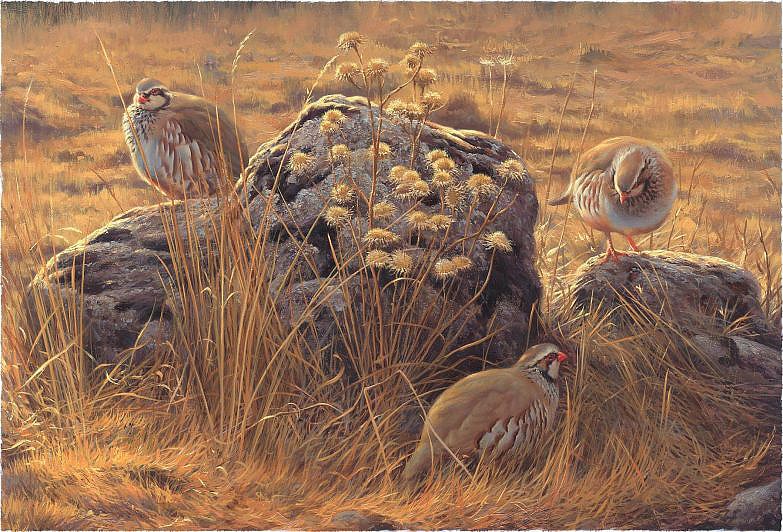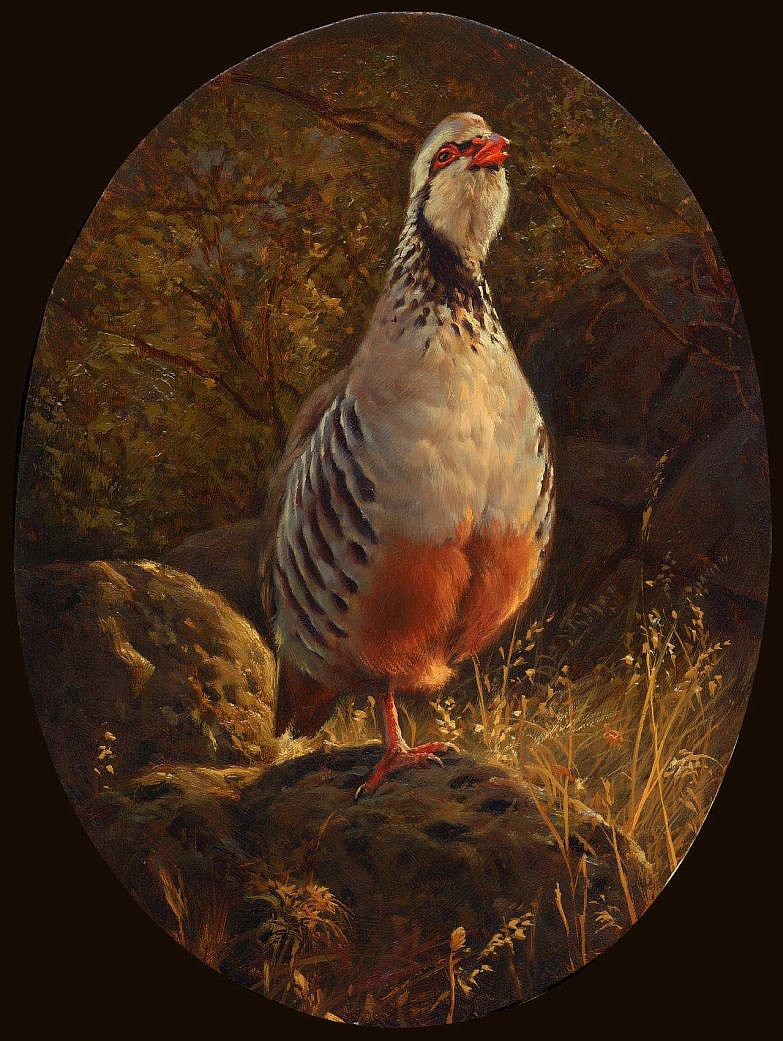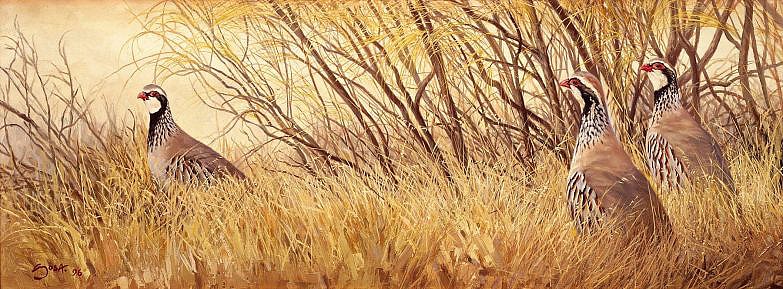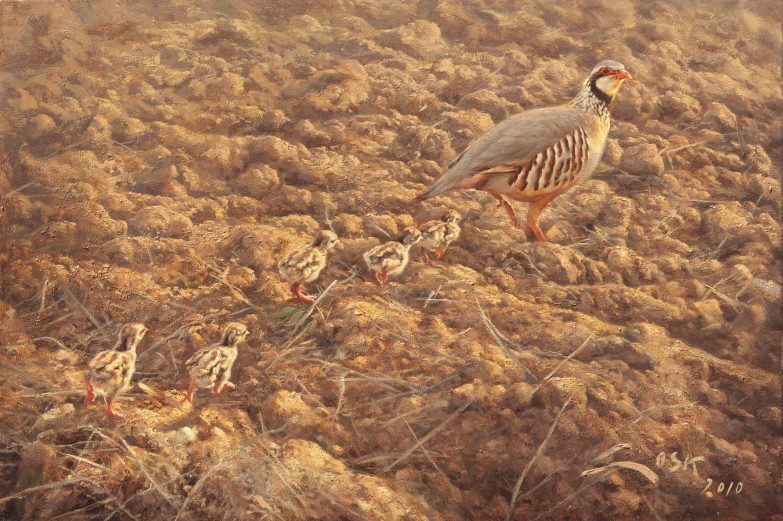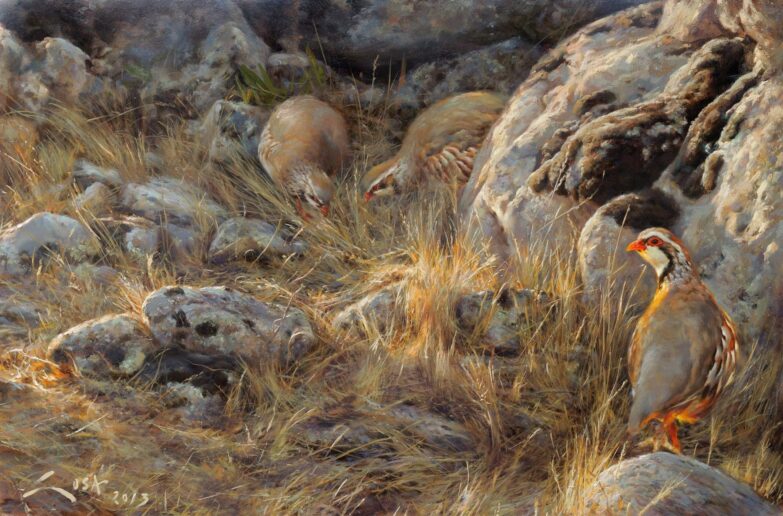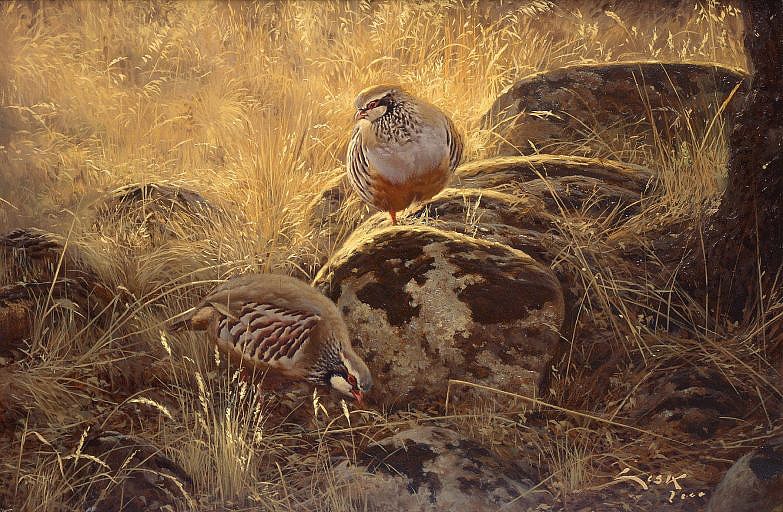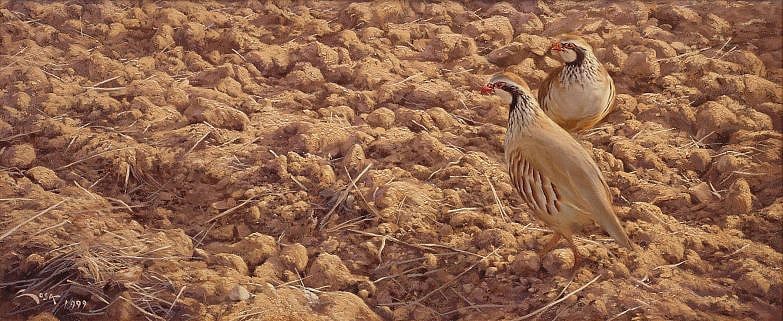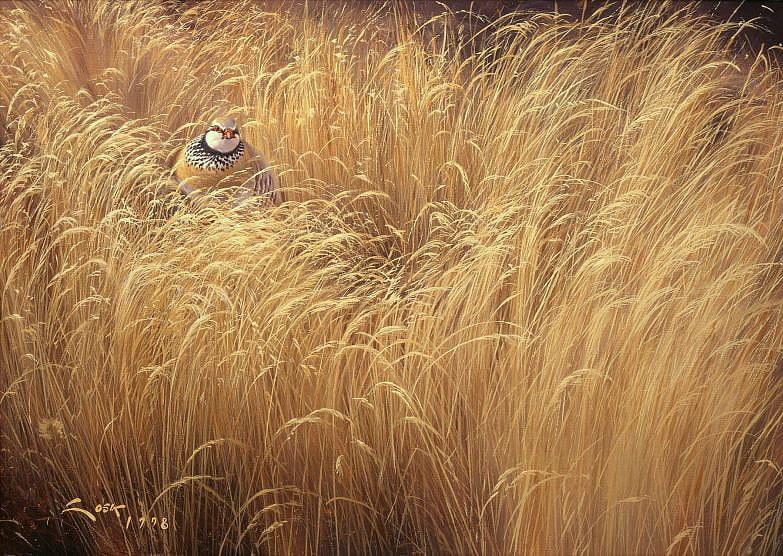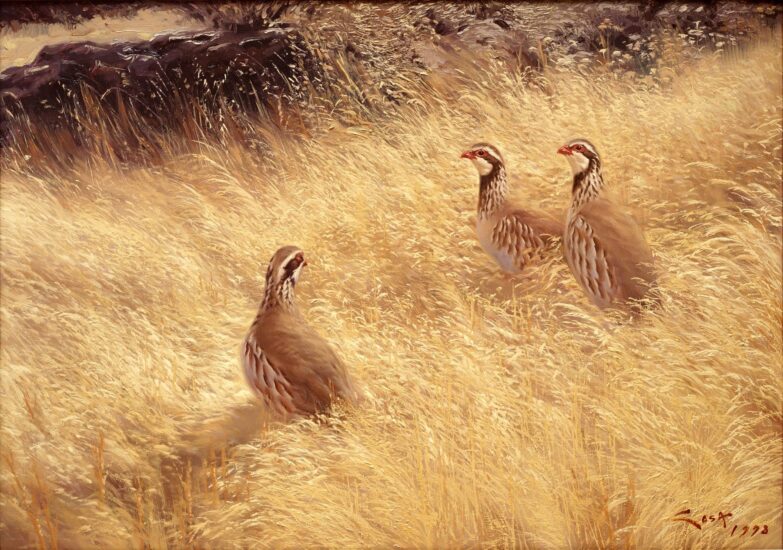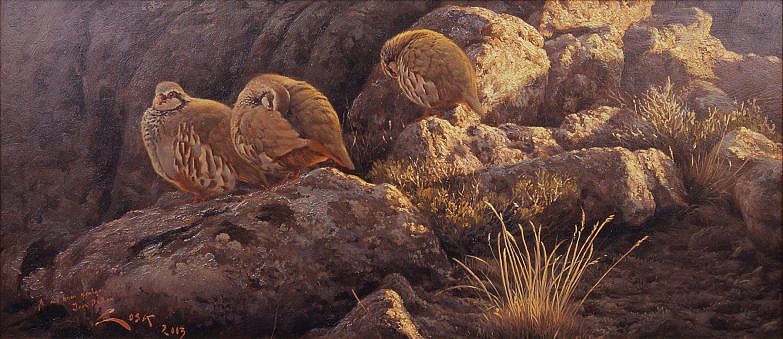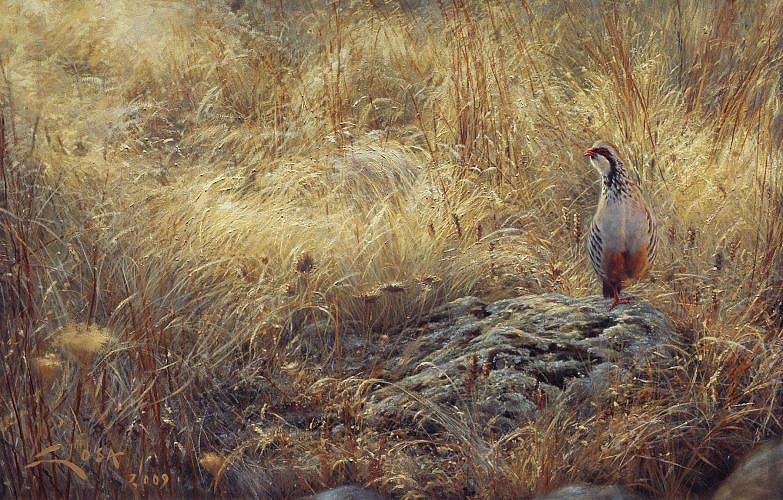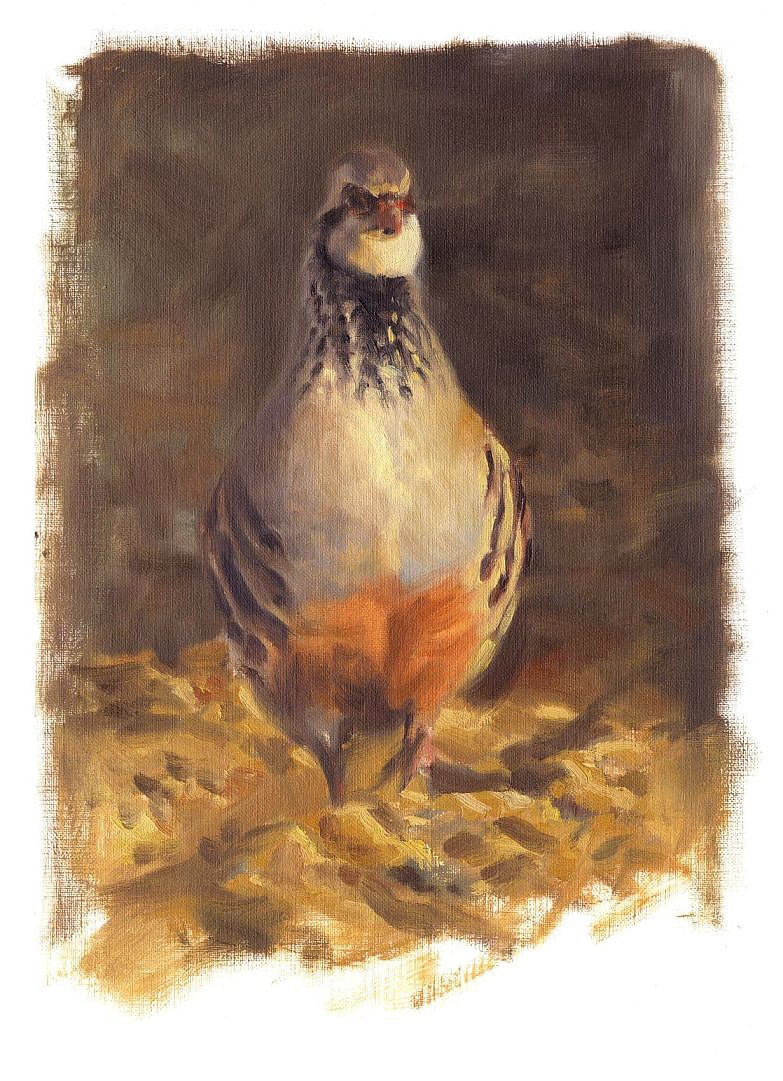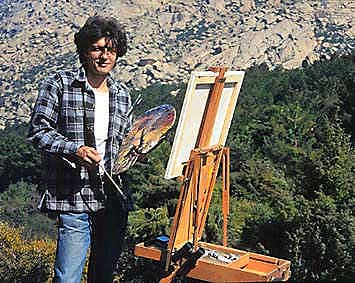The Red-legged Partridge
partridges paintings
Partridges and thistles
Red-legged Partridge (Alectoris rufa)
BUY A CANVAS PRINT:
| Buy |
THE ORIGIN OF A SPECIES
The partridge has been portrayed in pictures for centuries and has even been painted since primitive times. The pictures of partridges in this article have been painted by Manuel Sosa. Home millions of years ago, in the middle of the Tertiary era, rustic partridges, with unmistakable characteristics of belonging to the Galliformes order, must have roamed the meadows and forests of Europe. The rigours of increasingly cold and prolonged winters were beginning to weigh on them, pushing them year after year towards more southerly latitudes. This progressive cooling was the beginning of a long period of ice and snow that would eventually devastate much of northern and central Europe. These were the ice ages which, over the last 600,000 years, subjected our lands to a series of ecological changes so profound that they led to enormous variation in the distribution and abundance of many animals and plants.
During the long ice age - each glaciation lasted hundreds of thousands of years - the sparse grasslands of Artemis and Dryas offered their food in exceptionally harsh conditions. Few animals were able to adapt to this invasion of cold and snow and, as a result, the vast majority of species disappeared or were forced to retreat southwards, where, after passing through a fringe of conifers similar to today's taiga, oak and beech groves appeared, similar to those found today in Central Europe. It was in these Mediterranean oases where, fleeing from the cold, our primitive partridges took refuge.
Partridge in heat
Red-legged Partridge (Alectoris rufa)
| BUY A CANVAS PRINT:
You can choose a personal size |
The Iberian and Italic peninsulas, the Balkans, Anatolia and Barbary must have been centres of settlement for different populations of these tertiary partridges. In these areas, isolated from each other, these populations evolved according to particular paths that gave rise to the species of red-legged partridges that we now include in the genus Alectoris.
This genus comprises a series of partridges, mainly circum-Mediterranean, characterised by their coloured legs and beaks, throat edged with striking dark feathers, striped flanks and reduced spurs on their legs. Of the seven species of red-legged partridges, four are found in Europe.
The Moorish partridge (Alectoris barbara), characterised by its broad chestnut collar dotted with white and by its bluish-grey cheeks, throat and chest, lives in Barbary, as far as Cyrenaica, as well as in Gibraltar, Sardinia, Tenerife, Gomera and Lanzarote.
The chukar partridge (Alectoris chukar), with an all-black ruff, ochre throat and flanks with few but very marked stripes, is distributed from the Balkans and Anterior Asia to Mongolia and Manchuria, reaching as far south as northern India.The Greek partridge (Alectoris graeca), with a white throat and black ruff, also whitish, has greyish-brown dorsal parts and is found in the Alps, Italy, Sicily and the Balkan countries.
Finally, the Red-legged Partridge (Alectoris rufa), with a white throat, a black ruff that breaks up into small outward spots and a long white superciliary list, occupies the Iberian Peninsula, France - south of the Loire -, part of Switzerland and northern Italy, as well as Corsica. It was introduced to the Balearic Islands, Madeira, the Azores, Gran Canaria and England. The pictures of partridges painted here correspond to the Red-legged Partridge, so common in Spain.
These four species divided up the land favourable to them, so that there is no overlapping in their areas of distribution. This fact, studied by Watson, seems to indicate a geographical displacement that avoids competition between the different species of partridges.
The red-legged partridge
The common partridge o red-legged partridge has undergone a series of regional morphological variations or alterations which have given rise to the appearance of subspecies. This is a phenomenon common to all animal species which, through the double play of genetic mutations and selection, permanently adapt to the peculiarities of the environment.
But despite the slight racial variations, based above all on the different intensities and distribution of the colouring of their plumage, all red-legged partridges have the common denominator of being plump birds with a wingspan of just over half a metre. Sexual dimorphism, which is so pronounced in other pheasianids, is hardly apparent except in the fact that the female is slightly smaller than the male.
The morphology of their bodies, the arrangement of their legs and the way they walk indicate that they are marching birds. In small groups, they scour the ground for seeds, fruits or shoots, which, together with a wide range of insects and their larvae, worms and molluscs, constitute their food.
Partridges are certainly one of my favourite birds to portray, whether they are red-legged partridges, snowy partridges or linnets, and almost always as an excuse to enjoy painting the environment around them". Here, three red-legged partridges under a broom in a parched field. This painting is an oil on panel
Love and war
Cereal plains with shrubs and copses, vineyards, steppes, rocky and difficult terrain, scrubland and mountains are suitable for the adaptable partridge without difficulty above 2,000 metres. In all these biotopes, the spring song of the males resounds in the fields as early as February with thunderous sounds reminiscent of the noise of an old steam locomotive. These sonorous manifestations proclaim the possession of a territory and the need for a female to mate with.
In the 1950s, the English ornithologist D. Goodwin undertook a detailed study of the behaviour of the ptarmigan. He succeeded in describing the complicated behaviour of the males when, despite the intimidation of their owner's song, a foreign individual dares to enter their territory. In these cases, both males approach with their heads held high, slightly tilted to one side and slightly stretched backwards. They raise the feathers that border the white of the face and throat, presenting laterally this striking dewlap. The striped feathers on the flank close to the opponent are stretched up over the wing to form a clearly visible vertical plane.
Partridge with buckshot
Red-legged Partridge (Alectoris rufa)
| BUY A CANVAS PRINT: |
The wing on the opposite side, extended downwards, may touch the ground at moments of maximum excitement. The curious presentation of the flank and the retention of the wing in the folded position is explained in the sense that the flank markings are the main feature to be exhibited at all costs. With this picturesque appearance they circle around each other until they move into an active fighting phase, which only occurs when either of the two contenders is intimidated by the action of his adversary. They then leap at each other, trying to injure each other with their spurs while directing heavy pecks at each other. But the fight is rarely more than a simple tumble, for as soon as one of the individuals feels that he has borne the brunt of the skirmish, he leaves the battlefield.
Partridges in September
Red-legged Partridge (Alectoris rufa)
| BUY A LITHOGRAPH ON CANVAS:
You can choose any size |
In this way, the territories of the excise duties are being delimited.ted males while, with their singing, they bid to attract thea mate. When she finally appears, both the male and female will engage in courtship which, paradoxicallyIt is similar in its pattern to that of male-male fighting. At In this case, the process culminates in engagement rather than aggression.
Partridges and stubble
Red-legged Partridge (Alectoris rufa)
| BUY A CANVAS PRINT:
At the size of your choice |
This similarity between the two behaviours seems to be due toThe fact that, both in the territorial struggle and in the paraIn one case it is a nuptial relationship, an impulse of aggression predominates. inhibited by fear and the other by sexual attraction. The male of Red-legged Partridge courts his partner by crossing her path or circling around her. At other times, particularly If she appears after a short absence, the male presentstion and emits a noisy, loud kwerrooh! or a ¡000h! ¡000h! rushing towards it with its plumage fluffed out and the feathers on its nape erect.
Solitary partridges
Red-legged Partridge (Alectoris rufa)
| BUY A CANVAS PRINT: |
According to Goodwin's observations, supported by other authors, the male is responsible for building the nest. This is usually hidden under the branches of a bush or in the grass and is no more than a hole dug in the ground, barely limited by some dry leaves or grasses. In it, the female will lay 10 to 16 eggs, sometimes as many as 20. In captivity, there have been individuals with annual clutches of more than 110 eggs. The eggs are yellowish white or pinkish, spotted with brown and grey. They are 29.5 to 35.5 mm wide and 39 to 43 mm long. Their weight is 20 to 22 g. In some cases, it has been observed that the male builds a new nest, to which the female will come to lay another as soon as the first one is finished. In this way there are two nests to be shared between both parents. In these cases, the male, as well as the female, will be responsible for incubating and raising one of the broods. Goodwin considers that this behaviour normally occurs in the wild and that male and female do not differ in their care of the chicks, but on the other hand this is contradicted by the proven cases of polygamy. In any case, this is a relatively obscure point in the life of the partridge, since, although it is a popular and very common bird, it has been the subject of very few scientific studies. After 23 or 24 days of incubation, the partridge chicks hatch, weighing about 14g. Good nesters, they quickly leave the nest after 24 hours to scamper around the field in search of insects, which they feed on in the first few days. They have a pinkish down on the head, with brownish black splashes on the back and wings and three parallel yellow stripes. The yellowish underparts stand out slightly from the white throat. Behind the eye there is a small brown line. At 60 days they weigh about 200 g and at 90 days they have reached adult size. The young have a dull beak and legs and lack a black ruff and white eyebrow and throat.
Three red partridges
Red-legged Partridge (Alectoris rufa)
BUY A CANVAS PRINT:
You can choose a personal size
varying the original width (cms)
The code of sound communication between partridges has also been studied by Goodwin and reveals the existence of a wide variety of sounds that serve to maintain cohesion and promote group protection.
These family groups will more or less stick together. until the reproductive instinct is developing between their individuals. As sedentary birds, their radius of action remains They are reduced to an area that they do not leave and where they endure the harshness of winter, the attack of predators and the terrible pressure of man and his hunting gadgets. Only those partridges that live in the high mountains can be forced to hunt in the mountains.to make small altitudinal displacements in order to flee of the winter snow.
Poultry have been a great attraction for mankind. The red-legged partridge could not be less in this sense, as its appreciable size, the delicacy of its meat, its sedentary nature and its fondness for human crops were more than enough reasons to make it a coveted game.
Partridges preening
Red-legged Partridge (Alectoris rufa)
BUY A CANVAS PRINT:
You can choose a personal size
varying the original width (cms)
Rustic procedures, some of which are still used furtively, must have been used to capture it in times gone by. They could be hunted alive on the run, chased on foot or on horseback until exhausted by the third or fourth flight. Snares, crossbows or ingenious traps made of stone blocks held unsteadily in place by a framework of branches may also have been used. Eggs and chickens must also have paid their death toll to the predatory activities of the ancient Iberian peasants. With the appearance of firearms, new hunting techniques emerged.
Partridge in August
Red-legged Partridge (Alectoris rufa)
BUY A CANVAS PRINT:
You can choose a personal size
varying the original width (cms)
Attention was soon focused on our red-legged partridge, which, with its sonorous starts and dazzling flight, became one of the key pieces in small game hunting. Modalities such as the "ojeo", hunting in hand or hunting with a fierce claim have been and still are the object of great acceptance on the part of the hunting enthusiasts. But in recent times, parallel to the vertiginous increase in the number of hunters, a whole process of organising hunting has arisen, mainly with an economic aim in mind.
Red-legged Partridge
(oil study)
Red-legged Partridge (Alectoris rufa)
BUY A CANVAS PRINT:
You can choose a personal size by varying the original width (cms).
This is clear in the case of the partridge, which in many of these hunting grounds costs between 4 and 6 euros, not counting the registration fees for partridge hunting, which never fall below a few thousand euros. With such favourable prices, it is not surprising that many species of animals considered to be works of art have been protected and in many cases saved from clear extinction. The Red-legged Partridge has been one of these animals that has been favoured at times so excessively that it has undoubtedly been to the detriment of the species' ability to survive. In many hunting grounds, all possible predators of such a valuable animal have been eliminated by shooting, trapping or poisoning. In this way, the former breeding grounds of partridges hardened by the natural dangers of life have been turned into aseptic and peaceful breeding grounds. Moreover, since the yield of the hunting grounds depends on the number of partridges shot per season, a number of farms have sprung up at the same time, where enough partridges are bred to be able to carry out a series of releases prior to the big hunts.
SHARE IT ON
The authors
Article from the encyclopaedia of Iberian fauna by Felix Rodriguez de la Fuente, illustrated with the painter's paintings of partridges. Manuel Sosa.
. You are invited to enjoy his complete work on the website of his gallery. https://www.manuelsosa.com/

